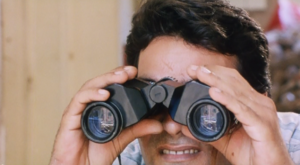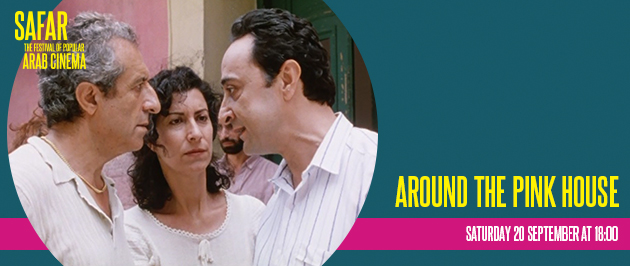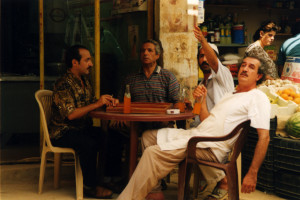Around the Pink House
Directed by Joana Hadjithomas and Khalil Joreige
1999 | Lebanon
Around the Pink House (Al bayt al Zahr in Arabic and La Maison Rose in French) is a portent for countries coming out of war and revolution. The urbanism of Beirut encapsulates in amplified form the experience of all evolving cities in the region. The Lebanese capital was demolished in the cause of development and reconstruction after a gruelling fifteen-year-long civil war.
In the film, two families who fled their villages in the country’s war-torn south cause comedic uproar as they fight eviction from their illegal home of eleven years. The Adaimis and Nawfals both inhabit a pink mansion in a highly desirable area near downtown Beirut, the fictitious Matba’a district. (This only becomes evident at the film’s end once the camera pans above the immediate rooftops to the war-torn city centre and beyond).
Joreige and Hadjithomas, originally from the Ashkal Alwan (the Lebanese Association of Plastic Arts) stable of artists and image-makers, are known for their feature film A Perfect Day (2006). Their documentary The Lebanese Rocket Society (2012) is evocation of Lebanon’s desire to enter ‘the modern world’ through an eponymous group of scientists and geeks who launched space rockets in the 1960s, from the hills around Beirut.
Around the Pink House, written and directed by Joreige and Hadjithomas, is their debut film, from 1999, which launched the duo’s film career as shrewd commentators on Lebanese history and social mores. Pink House is a morality tale about corruption, fanaticism and reconstruction, all played out in front of the camera of a local reporter, Daniel. As the Directors’ Note for the film states: ‘“All is well.” Or at least that is what everybody is led to believe in post-war Beirut. Reconstruction is booming. The war seems but a distant bracket [of time] that has been permanently [excised]. The country’s economy and the huge rehabilitation efforts around the city’s central district appear as a miraculous cure, papering over any remaining traces of a conflict that once existed. Amnesia prevails. The situation is looked at from the perspective of an old house, a pink palace of times long gone, damaged during the war, [forgotten about] as years swept by … The house operates as a witness to all those years, beholding so many memories.’
 The characters in The Pink House are always bickering, praying or trying to corral their young women relatives. Repeated petitions, a son’s fascist militia and another son’s art as well as a corrupt legal system fail to stop shopkeepers, property developers and financiers. Yet for all that, the families triumph through a growing sense of community and ultimately reverse the threat against them.
The characters in The Pink House are always bickering, praying or trying to corral their young women relatives. Repeated petitions, a son’s fascist militia and another son’s art as well as a corrupt legal system fail to stop shopkeepers, property developers and financiers. Yet for all that, the families triumph through a growing sense of community and ultimately reverse the threat against them.
So what is the moral of the tale? Perhaps it is that after all the countries of the Middle East who are currently undergoing war and conflict – Syria, Iraq and Libya – find some semblance of peace, they too will undergo a Beirut-style reconstruction of their devastated districts. This in turn will allow for the emergence of a new economic elite (although more than likely the old economic elite) who will slide effortlessly back into power. Meanwhile individuals cast into an almost unbearable situation, caused by political forces beyond their control will be lucky if, like the families of The Pink House, they receive a tiny bit of government compensation for all their hard-won efforts.
– Malu Halasa
London-based journalist writer and editor Malu Halasa is our writer-in-residence. Keep your eyes peeled for her posts in the run-up and during the festival.
For more information and to book tickets, please click here.


